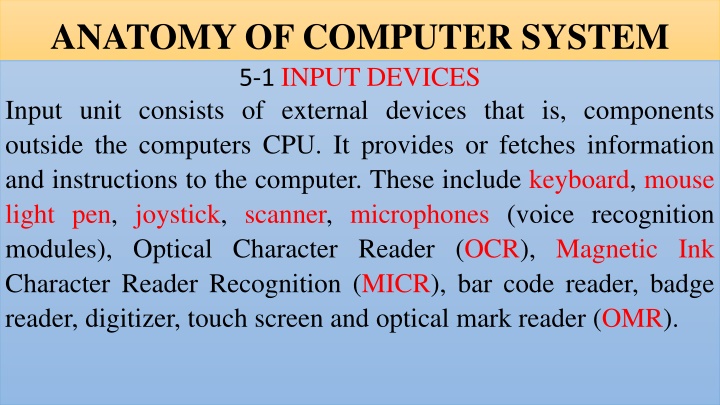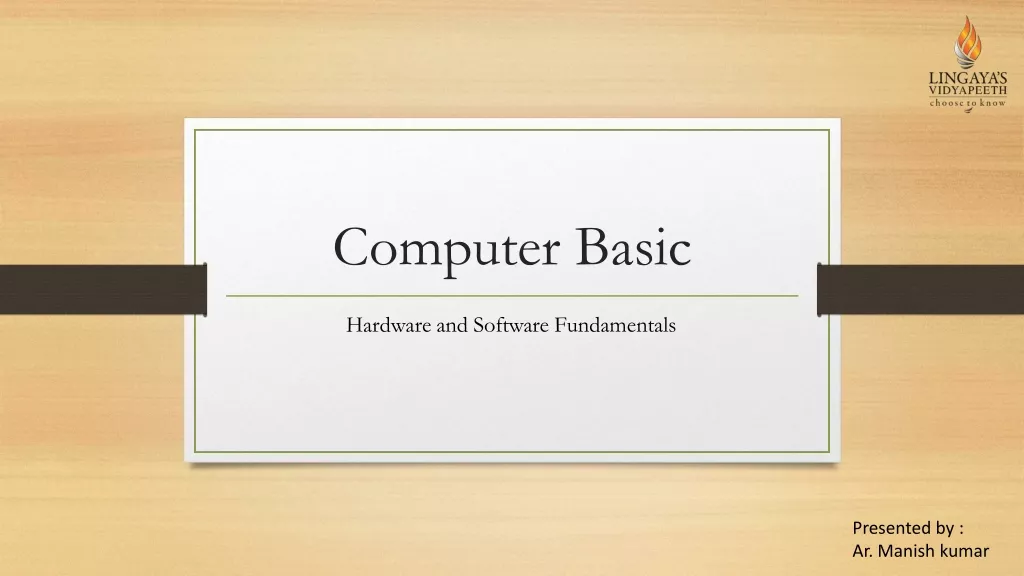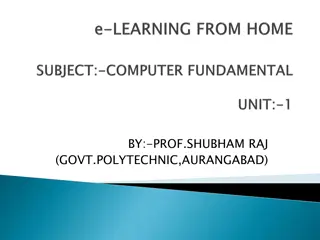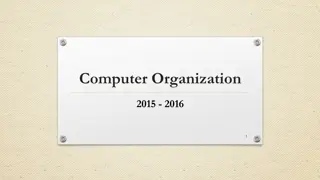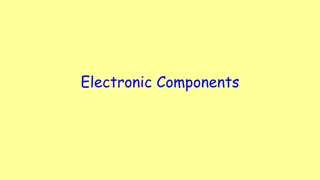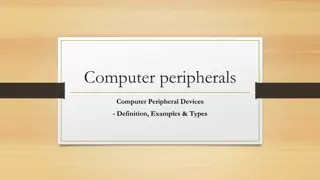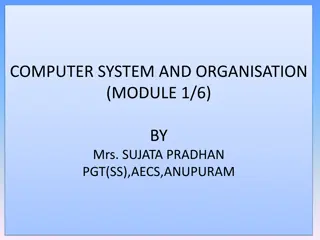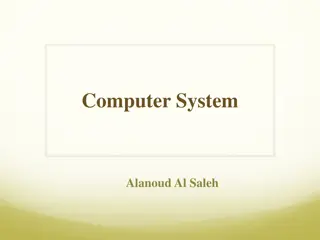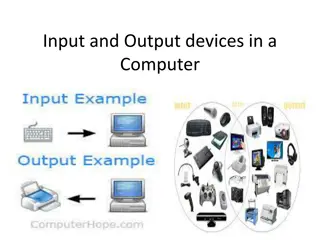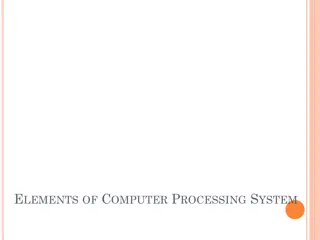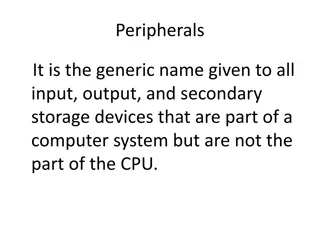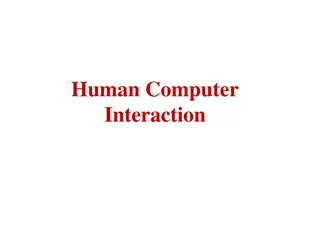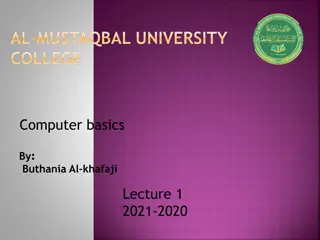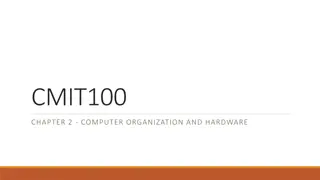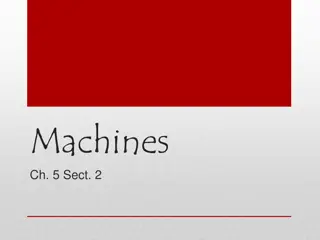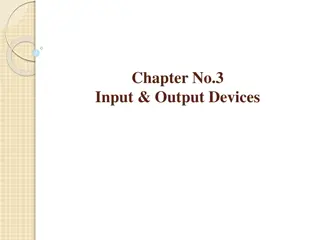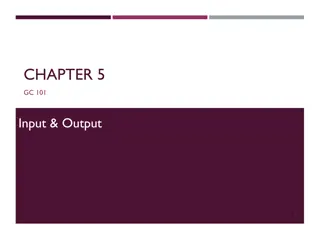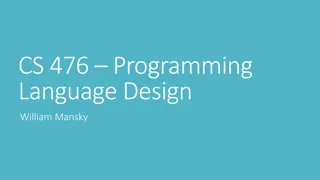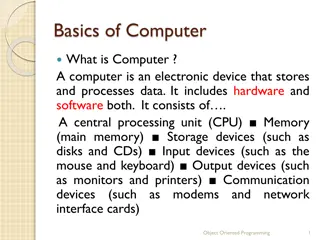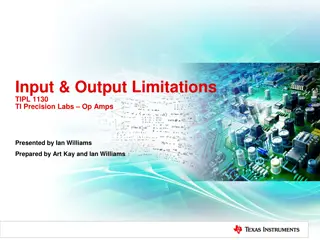Overview of Computer Input and Output Devices
Input devices of a computer system consist of external components like keyboard, mouse, light pen, joystick, scanner, microphone, and more, that provide information and instructions to the computer. On the other hand, output devices transfer information from the computer's CPU to the user through devices like monitors, printers, plotters, and speakers. Each input device serves a unique purpose, such as the light pen for direct screen interaction, mouse for cursor control, joystick for navigation, keyboard for typing, and microphone for sound conversion. Similarly, output devices like video graphic adapters and printers help display visual information and produce hard copies. Understanding the functionalities of these devices is essential in enhancing user-computer interactions.
Download Presentation

Please find below an Image/Link to download the presentation.
The content on the website is provided AS IS for your information and personal use only. It may not be sold, licensed, or shared on other websites without obtaining consent from the author.If you encounter any issues during the download, it is possible that the publisher has removed the file from their server.
You are allowed to download the files provided on this website for personal or commercial use, subject to the condition that they are used lawfully. All files are the property of their respective owners.
The content on the website is provided AS IS for your information and personal use only. It may not be sold, licensed, or shared on other websites without obtaining consent from the author.
E N D
Presentation Transcript
ANATOMY OF COMPUTER SYSTEM 5-1 INPUT DEVICES Input unit consists of external devices that is, components outside the computers CPU. It provides or fetches information and instructions to the computer. These include keyboard, mouse light pen, joystick, scanner, microphones (voice recognition modules), Optical Character Reader (OCR), Magnetic Ink Character Reader Recognition (MICR), bar code reader, badge reader, digitizer, touch screen and optical mark reader (OMR).
A.Light pen: This is a stylus with a light sensitive tip that is used to draw directly on a computers video screen or to select information on the screen by pressing a clip in the light pen or by pressing the light pen against the surface of the screen. The pen contains light sensors that identify which portion of the screen it is passed over. It is mostly used with Laptop. B. Mouse: This is a pointing device designed to be gripped by one hand. It has a detection device (usually a ball) on the bottom that enables the user to control the motion of an on-screen pointer, or cursor, by moving the mouse on a flat surface. As the device moves across the surface, the cursor moves across the screen. To select items or choose commands on the screen, the user presses a button on the mouse.
C. Joystick: is a pointing device composed of a lever that moves in multiple directions to navigate a cursor or other graphical object on a computer screen. D. Keyboard: Keyboard is typewriter-like device that allows the user to type in text, numeric and execute commands with the aid of the functional keys on the keyboard.
E. Microphone: This is a device for converting sound into signals that can then be stored, manipulated, and played back by the computer. A voice recognition module is a device that converts spoken words into information that the computer can recognize and process. F. Modem: It stands for modulator-demodulator, is a device that connects a computer to a telephone line or cable television network and allows information to be transmitted to or received from another computer. Each computer that sends or receives information must be connected to a modem.
5-2 OUTPUT DEVICES Output devices consists of hardware that transfer information from the computers CPU to the computer user. This includes the monitor, Printer, plotters, or speaker. 1.Video GraphicAdapter: This is a device that converts information generated by the computer into visual information called Monitor. It looks similar to a television set. Information from the CPU is displayed on the screen of the monitor.
3.Printers: Information and graphics processed or produced with the aid of computer are printed out as hardcopy with the aid of printer. There are different types of printers; Dot-matrix printers, Laser printers, Inkjet, etc. 4. Plotters: Computer output to microfilm or fiche (COM) which process information on rolls of film (drum plotter) or slide of film (flatbed plotter).
5-3 STORAGE DEVICES Storage devices provide permanent storage of information and programs for retrieval by the computer. The two main types of storage devices are: disk drives and memory. There are several types of disk drives: hard disk drive, floppy disk, magneto-optical, and compact disk.
1- Hard disk drives: Store information in magnetic particles embedded in a disk. Usually, a permanent part of the computer, hard disk drives can store large amounts of information and retrieve that information very quickly. The disks are of different sizes such as 1G, 10G, 40G, etc. 2-Floppy disk drives: Also store information in magnetic particles embedded in removable disks. Floppy disks store less information than a hard disk drive and retrieve the information at a much slower rate. It is of a 2 types 5 1/4 floppy disk and 3 1/2 floppy disk.
3-Magneto-optical disc drives: Store information on removable discs that are sensitive to both laser light and magnetic fields. They can typically store as much information as hard disks, but they have slightly slower retrieval speeds. 4- Compact Disc Drives: Store information on pits burned into the surface of a disc of reflective material such as CD-ROM. CD-ROMs can store about as much information as a hard drive but have a slower rate of information retrieval.
5- Digital Video Disc (DVD): This is similar and works like a CD-ROM but can store more than 15 times as much information. 6-Flash drives: Work as floppy disks but more sensitive as a hard disk that must be ejected logical before final removal from the computer system. It has more memory than floppy disks. 7-Memory Cards: Work as flash drive but with an additional device called the card reader. This is very effective and more durable than the flash drives.
Note Some devices serve more than one purpose. For example, floppy disks may also be used as input devices if they contain information to be used and processed by the computer user. In addition, they can be used as output devices if the user wants to store the results of computations on them.
